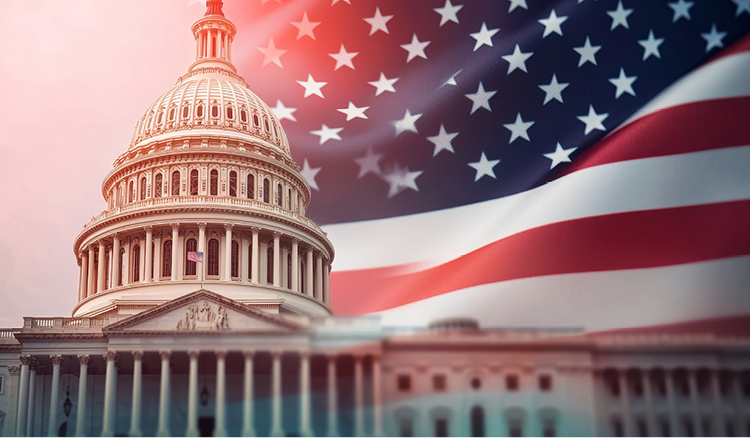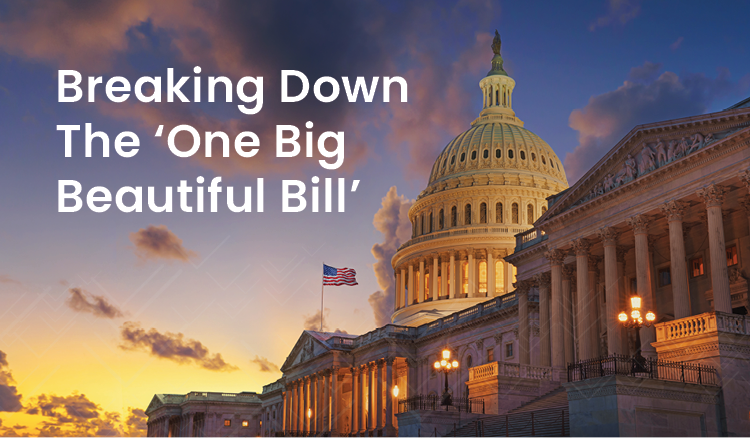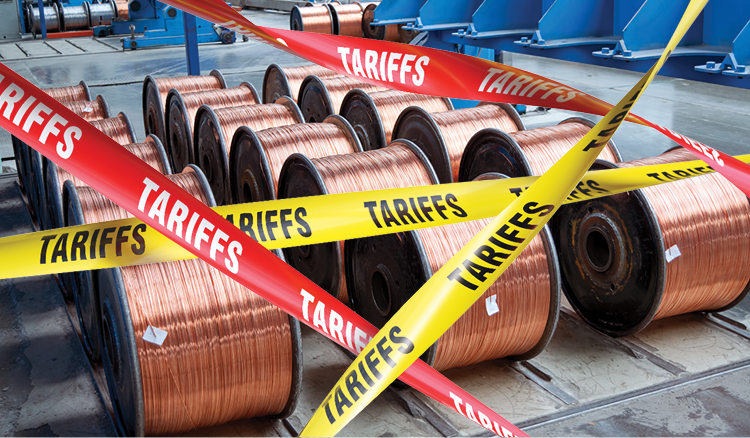Trump 2.0 Week 15 In Review: Discussing The Auto Parts Tariff Amendment, The Closing Of The De Minimis Loophole, and Much More
Just 100 days into Trump’s second term, numerous changes have taken place that will have a drastic impact on the U.S. economy, and especially the manufacturing and distribution sectors.
In this week’s recap article, topics covered include:
- Tariff relief granted to automakers
- The closure of the de minimis loophole
- Senate GOP leaders succeed in protecting tariffs
- China trade conflict update
- 1st Quarter GDP results
- Trump signs EO requiring truck drivers to speak English
Trump Grants Automakers Relief
While the tariff on imported vehicles already went into effect in April, the 25% tariff on imported parts is set to go into effect on Saturday May 3rd at 12:01AM.
Ahead of this, President Trump signed an executive order and proclamation on Tuesday aimed to ease the impacts and provide relief for up to 2 years as companies reshore supply chains.
As detailed in the proclamation, the amended order provides a rebate for one year of 3.75% relative to the sales prices of domestically assembled vehicles. That figure was reached by putting the 25% import tax on parts that make up 15% of the sale price. For the second year, the rebate will equate to 2.5% of a vehicle’s sales price, as it would apply to a smaller share of the vehicle’s parts.
In an interview with reporters, Trump stated “we just wanted to help them during this little transition, short term.”
While this proclamation certainly gives automakers the much needed relief they’ve been lobbying for, they’ll still have to move quickly and reshore production before this exemption expires.
De Minimis Loophole Expiration
The Trump administration first ended the de minimis loophole in February, however due to the fact that it completely overwhelmed the U.S. Customs and Border Protection employees and forced the postal services to temporarily halt packages from China and Hong Kong, Trump reversed course and delayed the closure.
A month ago on April 2nd, Trump signed an executive order ending de minimis treatment for goods from China and Hong Kong starting on Friday May 2nd at 12:01 a.m. EDT. While the original duties were 30% of their value, or $25 per item, given the escalating tensions with China the White House decided this wasn’t enough and tripled them. Now, packages sent to the U.S. from mainland China and Hong Kong with a value of up to $800 will face a 120% duty or a flat fee of $100. In June, the fee will rise to $200.
This loophole currently allows shipments worth less than $800 to enter the U.S. duty-free, and has been exploited in recent years as shoppers have gravitated to Chinese companies selling cheap goods like Shein and Temu. For context, from 2018-2023, the value of exports from China went from $5.3B to $66B, according to a report from the Congressional Research Service.
While much of the criticism of this rule has been due to the fact that it creates an unfair advantage for Chinese companies, the Trump administration’s decision to close it is mainly due to concerns that since the packages are less likely to be inspected by customs agents, the loophole encourages shipments of fentanyl and other illegal drugs.
As our Head of Reindustrialization Matt Horine discusses in Episode 4 of the U.S. Manufacturing Today podcast, closing this loophole accomplishes a few things:
- It levels the playing field and forces foreign sellers to pay their fair share.
- It constricts the flood of cheap foreign imports and will allow U.S. manufacturers to compete on quality, innovation, and reliability instead of being forced into a race to the bottom.
Already, Temu has said it will stop selling goods imported from China in the U.S. directly to consumers.
Senate GOP Leaders Succeed in Protecting Trump’s Tariffs
On Wednesday, the Republican-led Senate killed a resolution that would have effectively reversed Trump’s blanket 10% tariff on all imported goods.
Although several GOP Senators voted with Democrats in favor of the resolution, it still failed in a 49-49 vote. As far as the reason there were only 98 votes and not 100, both GOP Senator Mitch McConnell and Democrat Senator Sheldon Whitehouse did not vote. With both of these Senators opposing these tariffs, the Trump administration truly dodged a bullet here.
Earlier in the month, GOP senators also passed a similar resolution that would have reversed the tariffs on Canada.
While this is a big win for the Trump administration, the issue could potentially resurface down the road if economic conditions deteriorate.
China Trade Conflict Update
The tit-for-tat trade war with China has been the story of the month, and while things have cooled down considerably in the past few weeks, there’s still a lot of uncertainty regarding any ongoing negotiations and what the outcome might look like.
With that being said, progress is certainly being made on this front. Last week, China quietly rolled back some of their tariffs on U.S. imports, and Trump stated that Xi had called him. More recently on Friday, the Chinese Commerce Ministry announced that they are evaluating an offer from the U.S. to hold talks on tariffs. However, they also stated that they wouldn’t be forced into making a bad deal, and that “attempting to use talks as a pretext to engage in coercion and extortion will not work.”
While many have reported otherwise, the cards do appear to be in Trump’s hands. While he did acknowledge some of the price increases in a recent town hall, he also pointed out that China “is having tremendous difficulty because their factories are not doing business.” This isn’t just Trump’s opinion either, and the Wall Street Journal echoed a similar sentiment in their recent article “Chinese Manufacturers are Scouring the World for New Buyers”. For context, China’s factory activity fell to its lowest level since late 2023 in April. The decline in exports has truly been a major blow, as these sales account for roughly 20% of their economy. Additionally, Chinese consumers contribute less than 40% of total economic activity, compared to the nearly 70% in the United States.
Despite this, Chinese President Xi still refuses to stand down, and is hopeful that U.S. consumer outrage at higher prices or scarcities will force Trump to reverse course. While it’s certainly not hard to find consumers seething about higher prices, Trump’s base for the most part is standing with him, which is good news for the administration and crucial to keeping these tariffs in place. If his base starts to lose confidence, he’ll either have to walk them back or accept the possibility of losing both the House and Senate majority in the midterms, which would almost certainly mean the end of these tariffs.
Breaking Down The 1st Quarter GDP Report
While the newly implemented tariffs and conflict with China has certainly created some stock market volatility and caused consumer & business confidence to dip, the economy is holding up well overall.
While the 1st quarter results show that the economy retreated by 0.3%, much of this is due to the fact that companies intentionally loaded up on imported goods in anticipation of Trump’s tariffs. Specifically, imports surged by 51% which created a 4.8% headwind, which is 16X the actual 0.3% decrease.
Additionally, government spending declined by 0.3%, and consumer spending outpaced government purchases by largest margin since Q2 of 2022.
As stated by the Bureau of Economic Analysis: “Real final sales to private domestic purchasers, the sum of consumer spending and gross private fixed investment, increased 3.0 percent in the first quarter, compared with an increase of 2.9 percent in the fourth quarter.” Additionally, the Department of Commerce recently reported that consumer spending jumped 0.7% last month, on top of an upwardly revised 0.5% increase in February, surpassing expectations.
The bottom line: despite the fear-mongering coming from the media, the economy continues to advance.
Good news was also announced with regards to inflation. Wednesday’s report from the Commerce Department showed that the Personal Consumption Expenditures price index — the Fed’s favored inflation gauge — rose 2.3% in March from the year before, slower than February’s 2.7% increase. On a monthly basis, prices were unchanged, versus a rise of 0.4% in February.
Other New Developments
Trump Signs Executive Order Requiring Truck Drivers To Speak English
On Monday, President Trump signed an executive order that requires all commercial truck drivers in the U.S to be proficient in English or be put out of service. Under the order, a driver must be able to read and speak English “sufficiently to converse with the general public” to operate a commercial vehicle. In the near future, Transportation Secretary Sean Duffy will issue a new guidance on English proficiency testing and enforcement policies.
The reason for this executive order? In recent years, there’s been an alarming rise of CDLs issued to foreigners, which has resulted in a major increase in crashes and is an ongoing threat to public safety. American Truckers United is one organization that’s been sounding the alarm on this, and a few weeks back, co-founder Shannon Everett made an appearance on our U.S. Manufacturing Today Podcast to discuss this very pressing issue. Read More.
Mercedes-Benz to Add New Vehicle to Alabama Plant
On Thursday, luxury automaker Mercedes-Benz announced that it will add a new vehicle to its plant near Tuscaloosa Alabama by 2027. While they haven’t disclosed which vehicle will be produced here, the plant mostly produces SUVs. Either way, this is great news for Alabama workers and the local economy overall. As a Mercedes spokesperson explains, “the Alabama plant has established itself as the global export hub for Mercedes-Benz SUVs.” The company also said that roughly 60% of SUVs assembled at the plant are exported. Read More.
U.S. Job Growth Exceeds Expectations Despite Tariffs
Despite the volatility caused by trade policy changes, employers added 177,000 jobs in April. The unemployment rate also remained at 4.2%, according to the Department of Labor. Specifically, hiring was led by the healthcare, warehousing, and transportation sectors. This gain was considerably higher than many analysts had predicted, and have raised hopes that the U.S. economy can weather the uncertainty due to tariffs without collapsing. Read More.
Don’t Fear The Future, Build For It With Veryable
Each of these changes creates both opportunities and challenges, and those that will thrive are those that are agile and can quickly pivot. By partnering with Veryable, businesses gain access to a team of operational strategists and a proven strategy that not only improves key operational metrics, but positions them to navigate these changes with confidence. With a flexible workforce in place, businesses can respond proactively to changing market conditions, minimize fixed cost exposure, and seize new opportunities with infinite flexible capacity.
To learn more about how Veryable can help you win the next few quarters and beyond, check out these articles:
The Pressure That Creates Progress: Why Those Who Move First Win The Most: The companies that adapt first don’t just survive; they capture market share, drive innovation, and cement themselves as leaders. Those that hesitate become irrelevant, outpaced, or acquired by the competition.
Agility Drives Profitability: How Veryable Enable Rapid Business Pivots: Agility isn’t just a luxury—it’s a necessity. Companies that build flexibility into their labor model are best positioned to adapt, grow, and dominate their industries.
The Reshoring Reckoning: Why American Manufacturing Can't Afford to Wait This One Out: As tariffs and reshoring reshape global trade, American Manufacturing faces a pivotal moment. This article explores why operations clinging to rigid workforce models will falter while those embracing operational agility with Veryable will thrive.
Profiting From Preparation: Getting Paid to Build Your Operational Ark With Veryable: With Veryable, preparation isn’t just about readiness; it’s about opportunity. From day one, it creates profit and strengthens operations while preparing you for the unexpected.
U.S. Manufacturing Today Podcast
We’ve recently launched our U.S. Manufacturing Today Podcast. Hosted by our Head of Reindustrialization, Matt Horine, this podcast intends to help you cut through the noise you’re seeing across constructed narratives and provide clarity around these once in a generation policy shifts and their impact on the U.S. manufacturing sector.
Next week’s episode, which will be released on Tuesday May 6th, will provide deeper insight into the developments we’ve covered in this article. You can find this podcast on Spotify, Apple, YouTube, and PocketCasts.
Additional Resources
For more information on the changes taking place under Trump 2.0, make sure to check out our “Navigating Trump 2.0” page. Here you’ll find a breakdown of what’s happened so far and what’s potentially to come, as well as more articles laying out how manufacturers and distributors can thrive in this moment in time.
Previous Posts
Trump 2.0 Week 25 In Review: July Deadline Extended, 50% Copper Tariff Announced, and Higher Tariffs for Canada, Brazil, and BRICS
The Future of Manufacturing and Logistics
Create a free business profile today to explore our platform.






